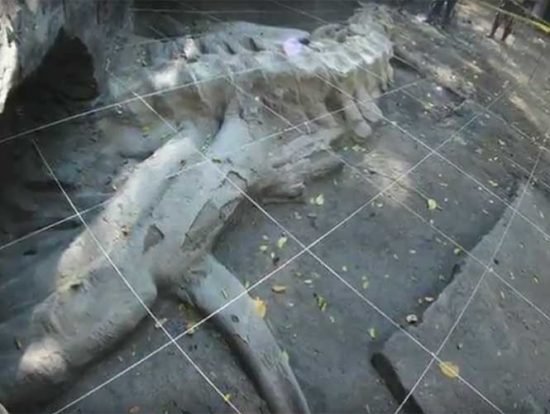Mexico is a rich source of paleontological discoveries. Here are four such recent discoveries, including one by a Nuevo Leon city’s mayor whose finding has been named after himself:
MEGALODON FOUND IN GUERRERO
The Megalodon (from the Greek for Big Tooth) is a species of extinct shark which, based on fossil evidence, could reach a length of up to 59 feet. Scientists dispute over which genus the megalodon belongs to, thus it has two disputed scientific names: Carcharodon megalodon vs. Carcharocles megalodon. Luckily, both names start with the letter C so it can be referred to as C. megalodon in scientific literature. (For an illustration of Megalodon about to swallow two small whales, click here:https://en.wikipedia.org/wiki/Megalodon#/media/File:VMNH_megalodon.jpg.
Because sharks have cartilage and not bone, Megalodon fossils aren’t usually well-preserved, but those which have been identified have been discovered in Europe, Africa, North and South America, Australia, New Zealand, India, Japan and even the Mariana Trench in the Pacific.
In December of 2016, the probable discovery of a Megalodon fossil in Mexico was reported in a river in the Mexican state of Guerrero. Pending investigations are to determine for sure if it’s a Megalodon.
NEW DINOSAUR SPECIES ANNOUNCED IN COAHUILA
In February of 2017, a newly-recognized species of dinosaur, excavated in the Mexican state of Coahuila, was announced. (Click here for a skull photo).
This dinosaur was discovered in 2007, in Coahuila, and has been studied for some ten years by Mexican and German paleontologists under the supervision of the Museum of the Desert in Saltillo. (It’s a first-rate installation, and I’ve visited it a few times.)
The name of the dinosaur species is Yehuecauhceratops mudei, and it measures about 9.8 feet in length. The mudei part stands for Museo del Desierto.
Now, it must be pointed out that in Mexico old-line politicians of the PRI (Partido Revolucionario Institucional) are called “dinosaurs.” And sure enough, in the comments section of the Excelsior article reporting on this species a smart aleck commenter asked, “¿No tenia algun distintivo del PRI?” That is, “Did it have a PRI insignia?”
PLESIOSAUR NAMED AFTER MAYOR
A plesiosaur is an extinct sea reptile. Well, a newly discovered plesiosaur species has been dubbed Mauriciosaurus fernandezi, in honor of its discoverer, Mauricio Fernandez, Mayor of San Pedro Garza Garcia, a municipio in the Monterrey metroplex.
In February of 2017 the plesiosaur was presented in a press conference, by Mexican and German paleontologists. As explained by Wolfgang Stinnesbeck of the University of Heidelberg, “In September of 2011 the remains of the marine reptile were found in 28 pieces of rock. Later, after its investigation, it has been established as a new genus and species in world science.”
The genus and species names were taken directed from the discoverer, mayor Mauricio Fernandez, who found it in the northern part of Nuevo Leon state.
Fernandez is one of Mexico’s richest men, part of the family that runs industrial conglomerate Grupo Alfa. Mauricio Fernandez is a collector of art, coins and fossils. In fact, his 600-piece fossil collection is said to be Mexico’s biggest.
Fernandez is also a politician of the PAN (Partido Acción Nacional), and he has been a Mexican senator, and mayor of San Pedro Garza Garcia (Latin America’s richest municipio) three times.
Fernandez has had three non-successive terms as mayor of San Pedro Garza Garcia, and was in his second term as mayor (2009-2012) when he found the fossil. And now he is in his third term (2015-2018) as the species is announced.
The Mauriciosaurus fernandezi fossil was well-preserved, measuring 1.9 meters and weighing 300 kilograms. The fossil skeleton was complete and contained much soft tissue.
Click here for a photo of Mauricio Fernandez and Mauriciosaurus fernandezi together.
A MAMMOTH MOLAR
The Nazas river, in northern Mexico, is dammed up for water control and irrigation, and in the Laguna region (on both sides of the Durango-Coahuila border) the river is dry. A mammoth molar was recently discovered by the dry Nazas river bed in the city of Gomez Palacio, Durango.
The researchers who found it were from the Facultad de Ciencias Biológicas de la Universidad Juárez del Estado de Durango (FCB-UJED). They found it while searching for mollusk fossils, then ran across the molar. It is believed to be that of a mammoth, but confirmation is pending. Click here for more information.
By Allan Wall for TYT
——————————
Allan Wall, an educator, resided in Mexico for many years. His website is located at http://www.allanwall.info.



